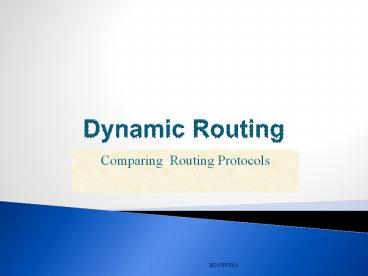Dynamic Routing - PowerPoint PPT Presentation
1 / 17
Title:
Dynamic Routing
Description:
RD-CSY3021 Criteria used to compare routing protocols includes Time to convergence ... (Routing Information Protocol) EIGRP Link ... (Open Shortest Path First) ... – PowerPoint PPT presentation
Number of Views:226
Avg rating:3.0/5.0
Title: Dynamic Routing
1
Dynamic Routing
- Comparing Routing Protocols
2
Criteria to compare routing protocols
- Criteria used to compare routing protocols
includes - Time to convergence
- Proprietary/open standards
- Scalability
- Classful/Classless
- Metric used
- Resource usage
- Implementation maintenance
3
Interior Gateway Routing
- Two Main Approaches
- Distance Vector Protocols
- E.g., RIP V1 and v2 (Routing Information
Protocol) - EIGRP
- Link State Protocols
- E.g., OSPF (Open Shortest Path First)
- Our Focus
- Comparing them
4
Routing Behavior
- Classful vs. Classless Routing Behavior
- -It is recommended to use classless routing
behavior - Reason so supernet and default routes can be
used whenever needed
5
Characteristics of classless routing protocols
- Classless Routing Protocol
- Routing updates include the subnet mask
- Supports VLSM
- Supports Route Summarization
6
Routing Protocol Algorithm
- Algorithm - procedure for accomplishing a certain
task
7
Link State vs. Distance Vector
- Link State (LS) advantages
- More stable (aka fewer routing loops)
- Faster convergence than distance vector
- Easier to discover network topology,
troubleshoot network.
8
RIP Routing Information Protocol
- Uses hop count as metric (max 16 is infinity)
- Tables (vectors) advertised to neighbors every
30 s. - Each advertisement upto 25 entries
- No advertisement for 180 sec neighbor/link
declared dead - routes via neighbor invalidated
- new advertisements sent to neighbors (Triggered
updates) - neighbors in turn send out new advertisements (if
tables changed) - link failure info quickly propagates to entire
net - poison reverse used to prevent ping-pong loops
(infinite distance 16 hops)
9
RIPv1 Problems (Continued)
- Split horizon/poison reverse does not guarantee
to solve count-to-infinity problem - 16 infinity gt RIP for small networks only!
- Slow convergence
- Broadcasts consume non-router resources
- RIPv1 does not support subnet masks (VLSMs)
- No authentication
10
Configuring RIP
11
RIPv2
- Why ? Installed base of RIP routers
- Provides
- VLSM support
- Authentication
- Multicasting
- Uses reserved fields in RIPv1 header.
- Supports authentication.
12
Link State Protocols
- Key Create a network map at each node.
- 1. Node collects the state of its connected links
and forms a Link State Packet (LSP) - 2. Flood LSP gt reaches every other node in the
network and everyone now has a network map. - 3. Given map, run Dijkstras shortest path
algorithm (SPF) gt get paths to all destinations - 4. Routing table next-hops of these paths.
- 5. Hierarchical routing organization of areas,
and filtered control plane information flooded.
13
Link State Issues
- Reliable Flooding sequence s, age
- Neighbor discovery and maintenance (hello)
- Efficiency in Broadcast LANs
- designated router (DR) concept
- Areas and Hierarchy
- Area types Normal, Stub, NSSA filtering
- External Routes (from other ASs), interaction
with inter-domain routing.
14
Hierarchical Routing
- Information hiding (filtered) gt
- less computation, gt
- less bandwidth requirement gt
- Less storage gt
- Improved efficiency gt leads to scalable
networks
15
Hierarchical OSPF
16
Hierarchical OSPF
- Two-level hierarchy local area, backbone.
- Link-state advertisements only in area
- each nodes has detailed area topology only know
direction (shortest path) to nets in other areas. - Two-level restriction avoids count-to-infinity
issues in backbone routing. - Area border routers (ABR) summarize distances
to networks in own area, advertise to other Area
Border routers. - Backbone routers uses a DV-style routing between
backbone routers - Boundary routers connect to other ASs (generate
external records)
17
Sample Area Configuration
10.2.0.0/24































